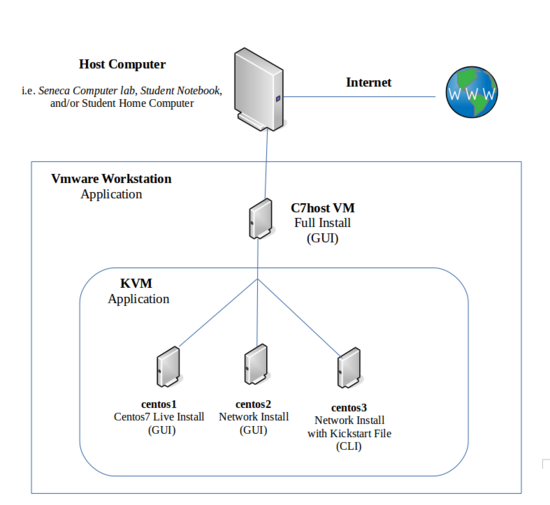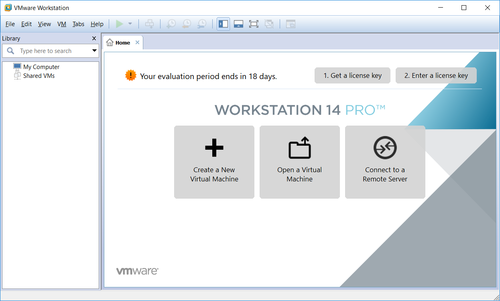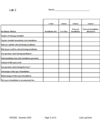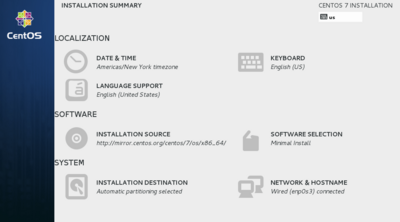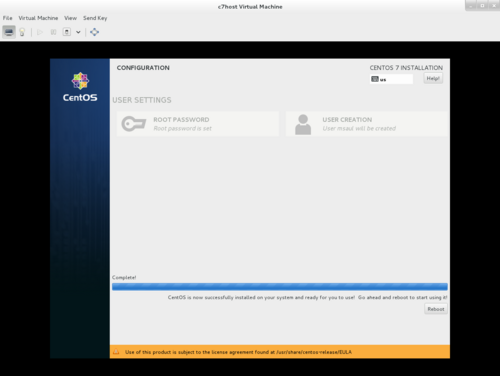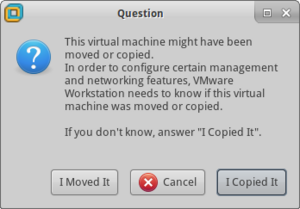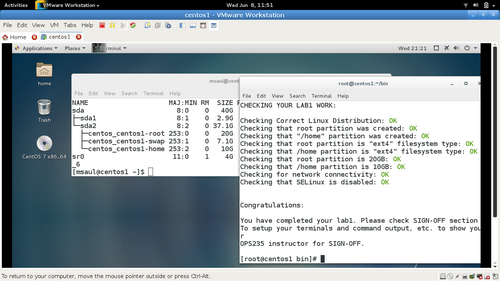OPS235 Lab 1 - CentOS7 - VMware
Contents
LAB PREPARATION
Purpose of Lab 1
You will learn how to use a popular Virtual Machine (VM) application called VMware Workstation in order to create and manage a virtual machine (Centos Linux - Full Install DVD). We will install three other Centos Linux VMs (using 3 different install methods) in lab2.
In order to save money and resources when learning to install, manage, and network various Linux machines for this course, we will be using virtualization for this course. In previous courses, students were required to purchase a removable hard disk drive to complete this course. You are NOT required (preferred) to use a removable hard-drive for this course. On the other hand, it is ESSENTIAL to have a USB key (minimum storage capacity of 16 GB) to save your Linux images in your temporary Seneca lab sessions and be able to work on your VM images on your notebook computer or desktop computer at home. You will learn during this lab how to obtain VMware Workstation 12 for your use for your notebook computer or desktop computer at home.
Main objectives
- Use VMware Workstation 12 to create and manager Virtual Machines (VMs).
- Install the CentOS 7 FULL INSTALL DVD as a new VM.
- Get Acquainted Using the Installed Virtual Machine
- Disable Linux Kernel security enhancements
- Properly backup Centos VM image to your USB Key
| Minimum Required Materials | Linux Command Reference | ||||
| VMware & Installation
VMware Workstation 12 Documentation Center |
Miscellaneous | ||||
INVESTIGATION 1: CREATE AND INSTALL FIRST VIRTUAL MACHINE (centos1)
In this lab, you will learn how to install your Centos Full DVD as a virtual machine using the VMware application. Make certain to record your observations of this install in the comparison chart for centos1 in your lab2 logbook.
Part 1: Using VMware Workstation 12 to Create a New Virtual Machine (VM)
centos1 VM Details:
- Name: centos1
- Boot media / Installation: CentOS7 Full Install DVD
- Memory: 16GB
- Disk space: 40GB
- CPUs: 1
Before you can install your Centos Full Install DVD onto your Virtual Machine, you must first create a storage container which is a virtual machine that will provide a platform for you to install your Centos operating system.
Perform the Following Steps:
- Refer to this listing of installation screenshots if you need a reference:
[ installation screen-shots ] - Power up the computer in your Seneca lab in Windows and insert the CentOS 7 Installation DVD into the DVD drive.
- On your Seneca computer workstation, run the VMware Workstation 12 application.
- Click on the item labelled Create a New Virtual Machine.
- Accept the Typical (default) for the Virtual Machine Configuration setting and click Next.
- Select your CD/DVD player (/dev/cdrom) as the default physical device drive and click Next.
- Make certain that the Guest Operating System is set to Linux and then click Next.
- Change the Virtual Machine Name to read centos1 and then click Next.
- Change the Disk Size to 40 GB and accept the default to Split virtual disk into multiple files and then click Next.
- Take a few moments to review the final summary screen to make certain that you make the correct configuration selections for your new virtual machine. If you notice an configuration problem, you can click the Back button to make corrections. If all is correct, then click Finish and click Close to complete the creation of your first virtual machine.
Part 2: Install Centos on your Newly-Created VM
The next step is to perform a custom installation for your Centos7 virtual machine using the Centos7 Full DVD. Upon creation of your centos1 virtual machine, The VMware Workstation application will automatically simulate a "boot" to allow you to complete the installation process to create the Centos7 operating system on that virtual machine.
Perform the following steps:
- Select from the installation menu: Install Centos7.
- Next, you will be prompted for a language. In the first screen, select language English with subselection English-Canada and then click the Continue button on the bottom right-hand screen.
- The Install Summary should now appear. This screen allows the installer to customize their Centos7 system prior to installation.
- Configure the following installation settings from the Install Summary Screen:
- DATE & TIME:
- Click on the Map to select Toronto area (you may also select from the drop-down menu section)
- Click the DONE button at the top-left corner to finish and return to the Installation Summary screen.
- NETWORK & HOSTNAME:
- Select the default Ethernet connection and click the button on the top right-hand side to change the setting from OFF to ON.
- At the bottom left-hand corner type the hostname: centos1 (all lowercase letters)
- Review your settings, then click the DONE button at the top-left corner to finish and return to the Installation Summary screen.
- SOFTWARE SELECTION:
- Select the software packages labelled: Gnome Desktop
- Click the DONE button at the top-left corner to finish and return to the Installation Summary screen.
- DATE & TIME:
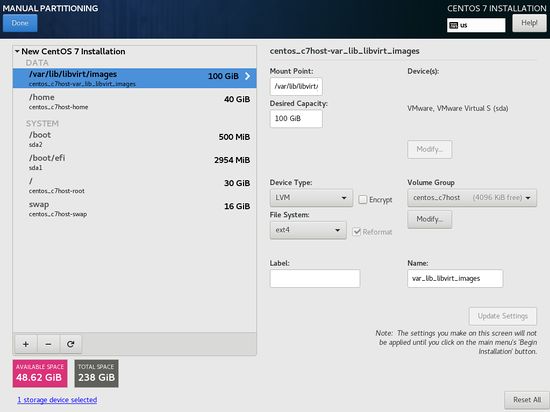 Carefully verify partition mount-names and sizes prior to proceeding with install. Check installation screenshots link for verification. |
- INSTALLATION DESTINATION:
- From the installation summary screen, click Installation Destination.
- In the installation destination screen, select the destination option: I will configure partitioning and then click Done.
- The manual partitioning screen should appear.
- If you have used your hard disk for previous Linux (Centos) distributions, you should remove them. Click on the distribution, and for each partition, select the partition and click the remove button (minus sign) and confirm deletion.
- Remember that the sizes are recorded in MB (eg. 20 GB = 20000 MB) and you should multiply GB by a factor of 1024 to get the correct size. (eg. 20 GB x 1024 = 20480 MB)
- INSTALLATION DESTINATION:
- We will now create the root (/) partition. Click on the add button (plus) sign.
- In the Add a New Mount Point screen, select / as the mount-point (either by typing or selecting from drop-down menu), and enter 20480 in for partition size and click Add Mount Point button.
- You will return to the previous dialog box.
For the / partition, change the file-system type from xfs to ext4 and make certain that the Device Type is set to Standard Partition (not LVM). You need to repeat this procedure for the /home and /var/lib/libvirt/images partitions as well). - Repeat the same steps above for the /home partition.
- Recheck each of the created partitions, and make certain that the file-system type is set to ext4 and the Device Type is set to Standard Partition.
- Finally, add a swap partition (Mount Point: swap) for 16 GB.
- Check that your partition settings are correct (you can ask your instructor or lab monitor to confirm), and then click Done (possibly twice) in order to proceed
- A Summary of Changes screen will appear to show the partitioning operations that will be created. Click the Accept Changes and click Begin Installation in the Installation Summary screen to proceed with the installation.
- Start timing your centos1 virtual machine installation.
Part 3: Completing the Installation
Perform the Following Steps:
- During the installation process, you will required to create a root password (for administration access) and create a regular user account. Click on Root Password and enter your root password. Think of an appropriate password and record that password somewhere in case you forget! An indicator will appear to show you how secure your password is. Retype your root password and click Done (you may have to click Done twice if your password is not considered to be a strong password).
- You need to create a regular user account. This account will be used to graphical log into your host machine. It is never recommended to graphically log into a graphical Linux/Unix system as root. It is better to log into a regular user account, then run a command to login as root (you will learn how to do this later in this lab).
- Click User Creation and enter your full name, username, and an appropriate password (and confirm password). Click Done to finish (click twice if password is not considered to be a strong password).
- Remember to record this host installation information in the installation comparison chart in the lab2 logbook.
- When installation is complete, you will notice a message at the bottom of the screen stating: CentOS is now successfully installed and ready for you to use!
- Click the Reboot button. Your DVD will briefly open in the DVD drive bay. Make certain to remove this installation DVD so that Centos will boot from your hard drive.
- After the system reboots, a boot menu should briefly appear, then prompt the user to accept the License Information (this is only a one-time occurrence).
In order to accept the license agreement, issue the following keystrokes:
1 followed by ENTER (to select the license agreement prompt
2 followed by ENTER (to accept the license agreement)
c followed by ENTER (to save the selection)
c followed by ENTER (a second time to continue booting into the system) - The system should then graphically prompt the user to login with their regular user account. Click on your regular user account name and enter your regular user password.
- The last phase of the installation process should now run:
- Confirm English as the default input source and click Next.
- Skip the creation of online accounts by clicking Next.
- Start using your installed Linux system by clicking Start Using CentOS Linux.
- Stop timing your installation and note the amount of time that your installation took to perform. Also take the time to fill in the centos1 section of the installation comparison chart in your lab2 logbook.
- Open a web-browser and check to see if you can connect to the Internet.
Answer Investigation 1 observations (all parts and questions) in your lab log book.
INVESTIGATION 2: GETTING ACQUAINTED WITH YOUR VM
For the remainder of this lab, we will be using the centos1 virtual machine that we installed in Investigation 1.
First, we will focus on using the virtual machine and become familiar with some command VM operations such as switching between the full-screen and window modes. We will also learn to turn-off the screen-saver settings so you do NOT have to periodically re-issue passwords to gain access to your account (although it is a good security feature to consider in the future beyond this lab). We will also show you how to temporarily log in as the root user in order to perform tasks that require a Linux administrator.
Part 1: Managing your Virtual Machine
VMware Workstation Toolbar
The VM Workstation application allows virtual machines to run in windows mode or full screen mode (which is toggled by pressing the key combination: ALT-CTRL-ENTER). You can press the key-combination ALT-CTRL in order to return to your host computer system (i.e. running the VM Workstation application. The VM Workstation Toolbar (displayed on right-hand side) can be accessed while in full screen mode when the mouse pointer is at the top of the virtual machine display.
Below is a table with some useful toolbar buttons and their purpose:
| Button(s) | Purpose |
| Toggle between auto-hide and always show toolbar | |
| Text-based menu for common operations | |
| Common Guest VM Operations (Left to Right):Shutdown, Suspend, Start, Restart | |
| Snapshot (i.e. Restore Points) (left to Right): Take new Snapshot, Revert to Parent Snapshot, Manage Snapshots |
|
| Exit Full Screen mode | |
| Running Virtual Machines |
Take a few minutes acquainting yourself with toggling into Full Screen mode, using the VM Workstation Tool-bar in auto-hide and always-show mode.
We will not be using the other features in this lab, but it is a good idea to make appropriate notes of these Tool-bar buttons and purposes in your lab logbook.
Turning Off Locked Screen-saver
Your system automatically enables a screen-saver application which is a useful security tool to prevent unauthorized viewing of information on a terminal after a certain amount of inactivity. Turning-off the locked screen-saver for this (and other) virtual machine can be useful when waiting for your instructor to come over to "sign-off" your computer lab without having to re-issue user passwords.
To Disable the Locked Screen-saver, Perform the following steps:
- Click on your username at the top right-hand screen
- Select Settings from the drop-down menu.
- Click the Power icon located in the Settings Dialog Box
- Change the amount of time in the Power Saving section to Never or a longer period of time
- Close the Settings Dialog box.
Disable SELinux and Perform Software Updates
SELinux stands for Security-Enhanced Linux. It is a component that helps to better secure the system to protect against intrusion (hackers). SELinux is enabled upon the default install of CentOS. SELinux can be a good thing, if you take care of it and know how it works. For this course it is strongly recommended that you disable SELinux by default because we won't have the time to reconfigure it every time the labs make it necessary.
Perform the following Steps:
- Disabling SELinux is quite simple.
- Edit the file /etc/selinux/config
- In the editing session, set SELINUX to disabled (from targeted) and save your editing session.
Part 2: Final Steps
Backing up Virtual Machines to a USB Key
As mentioned above, you need to backup your VM image files for ALL of your virtual machines that you create in Seneca's computer labs via a USB key to restore and continue your virtual machine sessions in future lab sessions. You can also move a virtual machine created in a host to another host for VM Workstation. For example, you can move saved image files to your home computer to complete labs, etc. Students can download the license key for VM Workstation 12 - refer to the following link for details: [ link ]
Backing Up VM to a USB Key:
Perform the following Steps:
- Shut down your centos1 VM.
- Determine the location that contains your centos1 virtual machine files. Here are some common locations for various Operating Systems:
| Operating System (Platform) | VM Directory Pathname |
| Windows | C:\Users\username\My Documents\My Virtual Machines\ |
| Linux | /home/userid/vmware |
| Mac OS/X |
- Create a zipped archive of the centos1.vmx file located in the centos1 VM directory.
- Copy the zipped archive to your USB key.
Restoring a VM from a USB Key:
- Perform the following Steps:
- To move work to your computer system running VMware Workstation, copy the archived file from your USB key to the appropriate VM storage location.
- Restore the archived file
- Launch the other VMware Workstation.
- Select File -> Open -> Browse to select the VM image in the centos1 subdirectory and a file labeled: centos1.vmx
- When starting the VM, you need to respond to the system prompt to confirm that you moved the VM to another platform.
- Proceed to Investigation 2 to obtain basic information from your newly installed centos1 virtual machine.
Answer Investigation 2 observations (all parts and questions) in your lab log book.
LAB 1 SIGN-OFF (SHOW INSTRUCTOR)
Download and Run Lab1 Checking Script & Show Lab1 Work
Shell scripting is so essential for Linux administration that this course has created a shell script for every lab for this course that a student must download and run in order to check their work. If you have performed the lab correctly, then you will get a series of OK messages and you can proceed with the SIGN-OFF for lab1. On the other hand, if there were errors, then a WARNING message will appear with general suggestions that you will need to fix on your centos1 VM in order to have your OPS235 sign-off in this lab in order to proceed to the next lab.
Perform the Following Steps:
- Launch your centos1 VM, open the Bash Shell terminal and issue the command:
su -and enter root's password. - Make a directory called /root/bin where you will be storing your shell scripts.
- Change to the /root/bin directory.
- Issue the Linux command:
wget http://matrix.senecac.on.ca/~murray.saul/ops235/lab1-check.bash - Give the lab1-check.bash file execute permissions (for the file owner).
- Run the shell script and if any warnings, make fixes and re-run shell script until you receive "congratulations" message.
- Arrange evidence (command output) for each of these items on your screen, then ask your instructor to review them and sign off on the lab's completion:
- ✓ Output of lsblk command showing correct partition names and sizes
- ✓ Lab1 logbook containing the values for:
- IP address, MAC address, Default route (gateway) and
DNS name server IP Address
- IP address, MAC address, Default route (gateway) and
- ✓ lab2 logbook with first column of Comparison Chart for centos1 VM.
- ✓ Output from running the lab1-check.bash script with all OK messages
Practice For Quizzes, Tests, Midterm & Final Exam
- Define the term Virtual Machine..
- List 5 reasons for using virtual machines.
- List the major screens (steps) in the installation of Centos7 full install DVD.
- What key-combination is used to toggle the view of your running VM from "window-mode" to "full-screen-mode"?
- List the steps for disabling SELinux.
- List the steps for backing up your VM image from a computer to a USB key.
- Why to you need to backup VM image to USB prior to leaving Seneca's lab?
- List the steps for restoring your VM image to a computer from a USB key.
- Write the Linux command to download the on-line file: http://linux.server.org/package.tar.gz
